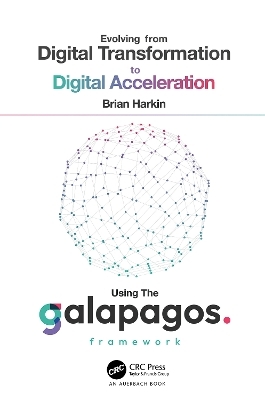
Evolving from Digital Transformation to Digital Acceleration Using The Galapagos Framework
Auerbach (Verlag)
978-1-032-51111-5 (ISBN)
Evolving from Digital Transformation to Digital Acceleration Using The Galapagos Framework challenges established thinking and offers a new way to deliver digital change. It introduces The Galapagos Framework, which is a new, innovative, and human-centric approach to transformational change. The framework allows organizations to move from digital transformation to digital acceleration, resulting in the creation of exciting and groundbreaking products as well as having a positive impact on the motivation and well-being of their teams.
Digital Acceleration is an iterative process that allows organizations to deliver transformations and demonstrate continual progress at pace. Rather than tackling the transformation as one large single event, Digital Acceleration enables organizations to improve one or, at most, two discrete areas of the business quickly and then move onto the next area needing improvement.
Presenting a detailed guide to The Galapagos Framework, the book also highlights solutions to common issues, expert case studies, and The Galapagos Roadmap. It discusses how the framework provides the key to increasing productivity, delivery velocity, and performance while reducing cost and complexity, ultimately resulting in digital and business success. The book demonstrates how The Galapagos Framework operates in practice to provide clear solutions to common issues that are classifi ed into Human Elements, Organizational Factors, and the Delivery Aspects. The book also explains why the current approaches to digital transformation are failing and shows how digital leaders and organizations can:
Increase productivity
Reduce costs
Improve delivery performance
Reduce operational, financial, and delivery risks
Increase profits
Deliver digital transformation success
Brian Harkin is a highly collaborative and trusted digital leader who leverages over 30 years’ experience across the financial services sector, principally global markets, asset management, and investment banking. Prior to creating The Galapagos Framework, Brian served in a variety of leadership roles and delivered numerous digital transformation programs across a range of business domains, including digital channels, ecommerce, and data and risk analytics. In addition to his freelance work, Brian is a passionate coach/mentor/ educator and is a visiting lecturer at City, University of London’s Bayes Business School. He also writes and presents extensively on digital transformation and leadership.
1. Introduction, Overview, and Definitions 2. Digital Transformations: TheCommon Issues 3. Introduction to The Galapagos Framework 4. The Function of The Galapagos Framework 5. Moving from Digital Transformation to Digital Acceleration 6. Emerging Better Practices SECTION I HOW THE GALAPAGOS FRAMEWORK RESOLVES THE COMMON ISSUES A. THE HUMAN ELEMENT 7. The Human Element: Culture 8. The Human Element: Communication 9. The Human Element: Skills 10. The Human Element: From Culture to Competitive Advantage B. THE ORGANIZATIONAL FACTORS 11. The Organizational Factors C. THE DELIVERY ASPECTS 12. The Delivery Aspects 13. How Does the Galapagos Framework Work in Practice? 14. The Island 15. The Island: Leadership Function 16. The Island: Go-to-Market and Delivery Functions 17. The Island: Coordination Functions 18. The Island: Ancillary Go-to-Market Functions 19. The Model 20. The Working Environment 21. A Few Essentials 22. Current Approaches and Why They Don't Work 23. The Role of Social Media in Digital Transformations 24. The Leadership Gameplan 25. Readiness Review and Digital Maturity Assessment 26. The Customer Proximity Principle 27. Closing Thoughts 28. Case Study Rose Story Part 1: Toxic Culture 29. Case Study Rose Story Part 2: Leadership Vacuum 30. Case Study Joanne's Story Part 1: Leadership Conflict 31. Case Study Joanne's Story Part 2: Heavy-Weight Governance 32. Case Study Tony's Story: Working Environment 33. Case Study Phil's Story: The Galapagos Framework and Success Appendix A. A Guide to the Leadership Guide Appendix B. Example Technology Matrix Appendix C. Example Metrics Appendix D. Example Technologies and Architecture for Web-based Applications Appendix E. Glossary
| Erscheinungsdatum | 17.04.2024 |
|---|---|
| Zusatzinfo | 29 Line drawings, color; 29 Illustrations, color |
| Verlagsort | London |
| Sprache | englisch |
| Maße | 156 x 234 mm |
| Gewicht | 720 g |
| Themenwelt | Mathematik / Informatik ► Informatik ► Theorie / Studium |
| Wirtschaft ► Betriebswirtschaft / Management ► Planung / Organisation | |
| Wirtschaft ► Volkswirtschaftslehre | |
| ISBN-10 | 1-032-51111-7 / 1032511117 |
| ISBN-13 | 978-1-032-51111-5 / 9781032511115 |
| Zustand | Neuware |
| Haben Sie eine Frage zum Produkt? |
aus dem Bereich


